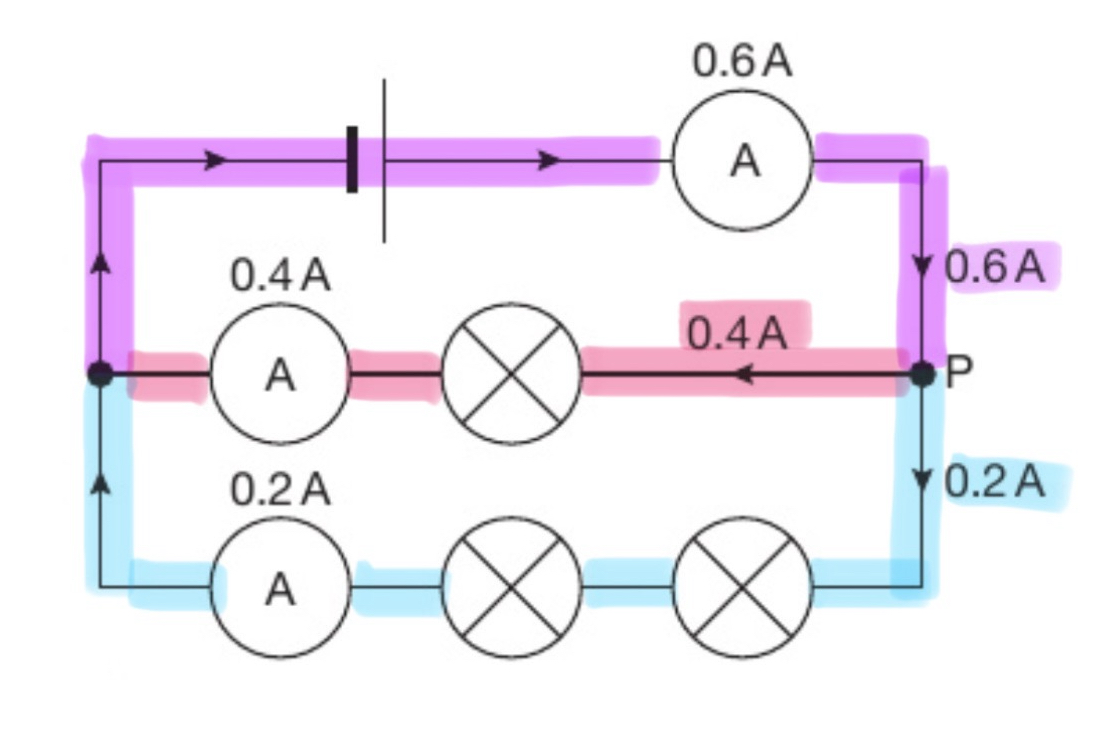Electricity: series and parallel circuits
1/6
There's no tags or description
Looks like no tags are added yet.
Name | Mastery | Learn | Test | Matching | Spaced |
|---|
No study sessions yet.
7 Terms
Electricity
What does a circuit in series look like? What are the characteristics?
Components are connected end to end in one loop.
Voltage is shared across all components (depending on their resistance bc of V=IR. So components with higher R will have a higher V)
Vtotal = V1 + V2 + V3…
Current is the same everywhere in the circuit
Measure current with an Ammeter (place in series). Bc current is te same everywhere, we can place it anywhere.
Resistance: total resistance is the sum of the R of all components
Rtotal = R1 + R2 + R3…
What does current depend on? How? (Lo pongo en un flash card distinto porque es un objective (2.8) en el spec)
Current in a series circuit is the same everywhere; it is not used up
Voltage & the number and nature of components (resistance)
As voltage increases the current also increases.
If a second identical cell is added in series, the voltage will double and so the current will also double (= all bulbs in the circuit are brighter)
In general, the more components in a circuit, the lower the current.
More components = more resistance = less current = less bright
By “nature” it means how much resistance that component has by itself
What are characteristics of series circuits (containing bulbs)?
Textbook:
One switch placed anywhere in the circuit turns all the bulbs on and off (advantage)
If one component breaks/stops working, the whole circuit stops working as it is incomplete/there is a gap (disadvantage)
Very bad downside so very few things are connected in series
Voltage (energy) is shared between all bulbs, so the more bulbs you add the less bright they become
No textbook:
More components = more resistance = less current = less bright
Fewer wires, cheaper and easier to assemble
Suitable for low power devices
Voltage is shared
What does a circuit in parallel look like? What are the characteristics?
Components are connected to the power supply in separate branches (more than one loop)
Potential difference/voltage is the same everywhere.
If battery has 12V, loop one will have a voltage of 12V, loop two also 12V, etc
Current is shared between each loop.
I total = I1 + I2 + I3…
So if a circuit with 2 branches has a total current of 4A, we can expect that the sum of the current flowing in both branches = 4A.
So, loop A could = 3A and loop B = 1A or both could be = 2A, depending on their resistances. Bc of formula I = V/R, higher resistance means it has a lower current bc it is harder for charge to flow.
Also there are junctions where the current splits or rejoins.
So, the total current going into a junction must equal to the total current leaving it.
For example, in diagram, current that enters junction P = 0.6A. The current that leaves is 0.4A + 0.2A = 0.6A
Also current in each loopy loop is the same (colours). E.g all path in blue has a current of 0.2A
Resistance in parallel circuits: adding more resistors in parallel = lower total resistance
This is bc there are more paths for the current to pass through

Characteristics of parallel circuits
Switches can be placed in different parts of the circuit to switch each bulb on and off individually or all together
If one bulb breaks, Only the bulbs on the same branch of the circuit will be affected, the rest continues functioning.
Each branch of the circuit receives the same voltage, so if more bulbs are added to a circuit in parallel (add a new branch), they all keep the same brightness.
Not textbook:
Useful for high powered devices.
What uses do we see series or parallel circuits in?
Serie circuit for decorative lights/fairy lights
Each bulb only needs low voltage so even when the V from the mains supply is shared, they still get enough energy to produce a light.
All switch on/off at the same time
However if the filament in one of the bulbs break, then the rest will also go out
Parallel circuit for domestic lighting
If one bulb stops working, the other light bulbs continue to work as they are still in complete circuits.
Also components can be switched on/off independently
The brightness of each light does not change when other lights are on/off